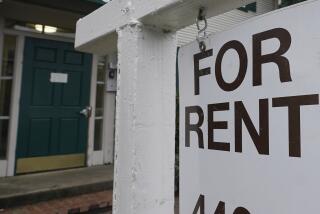Rent Subsidies Feeling Squeeze in Tight Market
- Share via
Southern California’s rental market is so tight that tens of thousands of people are seeking federal rental subsidies although fewer landlords will accept them.
The Orange County Housing Authority expects 15,000 people to apply for housing assistance when it reopens its waiting list on June 1. But housing officials estimate that just 77% of those who receive the subsidy, known as Section 8, will find a landlord who will accept it.
The Los Angeles Housing Authority, which has a waiting list of about 130,000 city households seeking the subsidy, reports that only 50% of qualified recipients will find Section 8 housing. A decade ago, about 90% of those eligible renters found apartments.
That Los Angeles city list, kept open since 1998, is so long that some applicants are not expected to get the aid until 2007, officials said.
Housing experts say the cause is obvious: money. Because of the flood of prospective unsubsidized renters willing to pay top dollar, more landlords are snubbing subsidized tenants. The vacancy rate in both counties is a minuscule 3%.
Don Smith, executive director of the Los Angeles Housing Authority, notes that rents have increased by 13% in the city but that HUD has proposed only a 5.2% hike in its payments to landlords in the fall.
“This is a market program,” Smith said of Section 8 vouchers. “A market program ought to react to the market.”
John Hambuch, a manager of Orange County Housing Authority, agreed. “In the early 1990s, there were lots of vacancies. Section 8 was welcomed. There were incentives, even TV sets, for people to move in. That’s not heard of anymore,” he said.
Section 8, a federal program created in 1974, allows recipients to pay 30% to 40% of their salary for rent; federal funds from the U.S. Department of Housing and Urban Development and administered locally pays the landlord the rest.
In Orange County, a family of four can earn no more than $36,850 annually to qualify for Section 8. In the Los Angeles area, that family is limited to about $27,000.
Charles Isham, vice president of the Apartment Assn. of Greater Los Angeles, said landlords have become less receptive to the program because the Section 8 bureaucracy is “squeezing owners for less rent.”
Building inspections by “overbearing and officious” housing authority officials and delayed rental payments also have made accepting Section 8 renters more of a burden, he said.
Of the 18,000 Los Angeles landlords last year, 3,000 had dropped out of the program, leaving “swaths” of the city where vouchers are no longer accepted, said Steve Renahan, Los Angeles Housing Authority director of Section 8.
“More and more owners are saying no,” said Renahan, acknowledging that recent bureaucratic changes to the program have made more apartment owners “take a look at their options.”
About 40,000 households in the city of Los Angeles receive Section 8 subsidies, compared to 7,600 households in all of Orange County.
Because demand for the help has far exceeded the supply, tenant advocates such as Larry Gross, director of the Coalition for Economic Survival, said more tenants are seeking legal help. The tenants are being evicted because apartment owners are no longer accepting Section 8.
In April, Blanca Sanchez, 42, and husband Javier Ovieto, 39, of Hollywood received notice that their Section 8 subsidy would no longer be accepted--and that their monthly rent was jumping from $750 to $1,356.
The couple, who depend on Section 8 to pay half the rent on a two-bedroom apartment on Yucca Street, are scraping to provide for three teenagers and a new granddaughter. Ovieto is unemployed and looking for a restaurant job, and Sanchez works in a welfare labor training program.
“I don’t know what to do,” said Sanchez, whose Spanish was translated by her daughter Leslie. “I have no money for a down payment. I have to move all of my family.”
The family of six has lived in the Hollywood apartment for the last seven years.
A manager for Hollywood Pointe Inc., owner of the Yucca Street building, confirmed the landlord no longer accepts Section 8 but refused to discuss the matter further.
In south Orange County, many landlords no longer participate in the program, and countywide most apartment complexes limit the number of Section 8 renters to one or two units.
Even so, Orange County housing officials expect a relative stampede when the agency reopens its waiting list for the assistance in June--a list that adds new applicants only every few years. Demand is heavy because the average rent in the county hit $1,166 in 2000, an all-time high.
Section 8 was envisioned as an alternative to conventional public housing projects and designed to give low-income families the freedom to choose their own homes with government rental subsidies.
In 1999, the last time Orange County Housing Authority opened its Section 8 waiting list, 7,500 people applied--and the two-week enrollment period was not well-publicized, Hambuch said.
“It could be a lifesaver for a lot of families,” he said. “It could be a way for them to stay in the county instead of leaving the area.”
The agency decided to reopen the waiting list again in June because only 1,500 names remain on the current list--and many of those people may no longer qualify or may have moved. The county has received 740 more Section 8 vouchers this year because of increased federal funding to the county, Hambuch said.
More to Read
Sign up for Essential California
The most important California stories and recommendations in your inbox every morning.
You may occasionally receive promotional content from the Los Angeles Times.






